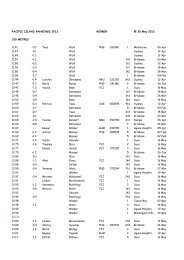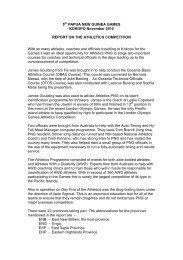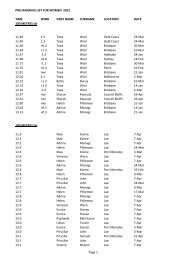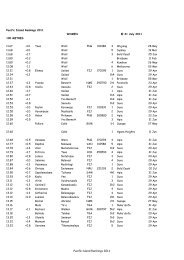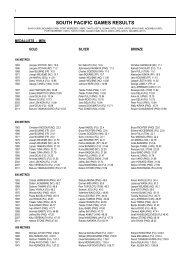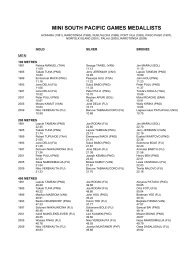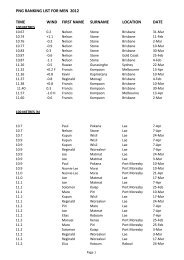pacific games, noumea 2011 - Oceania Athletics Association
pacific games, noumea 2011 - Oceania Athletics Association
pacific games, noumea 2011 - Oceania Athletics Association
You also want an ePaper? Increase the reach of your titles
YUMPU automatically turns print PDFs into web optimized ePapers that Google loves.
Physical conditioning<br />
Being prepared physically not only improves sporting<br />
performance but helps prevent injuries. Being physically<br />
prepared means the athlete can perform the given task<br />
without injury because there are no un-wanted<br />
movements of the limb because there is enough stability<br />
and /or strength to overcome any movement alteration<br />
without injury occurring and physical.<br />
A close analysis of the requirements of the individual<br />
event by the coach and sports science coordinator is<br />
essential to minimise the chance of injury. This analysis<br />
will identify the physiological requirements on the body,<br />
muscle strength, length and co-ordination required to<br />
participate and the designing of a specific training<br />
program to best prepare the athlete for the demands of<br />
the event.<br />
Technique<br />
Malalignment or biomechanical problems in the athletes<br />
movements such as pronated feet, internal rotation of<br />
the knee have been associated with injury. It is<br />
important to identify the risky elements in the sport and<br />
learn the correct technique at all times, to prevent injury.<br />
If it is difficult for the athlete to perform the activity<br />
optimally, then consultation with a Physiotherapist or<br />
Exercise Physiologist or specialised coach in the event<br />
will help identify the reason for this and a program of<br />
stretching or strengthening or skill based drills can be<br />
designed to eliminate any unwanted and potential injury<br />
risk factors.<br />
Sporting equipment<br />
It is important to buy the correct sporting equipment<br />
(e.g. shoes) and take care of the equipment to prevent<br />
injury. A simple sign that there is a problem with<br />
equipment is that the athlete will start to develop strange<br />
or out-of-the ordinary aches and pains after using or<br />
wearing the equipment.<br />
Hydration and nutrition<br />
An understanding of how hydration and nutrition<br />
affects the body‘s ability to recover and respond to<br />
training enables the athlete to make better food and fluid<br />
choices before, during and after exercise. The right<br />
hydration and nutrition program will prevent fatigue and<br />
reduce the subsequent risk of injury that is associated<br />
with fatigue both at a physiological level (tired muscles)<br />
and psychological level (poor concentration).<br />
Environment<br />
Ensure that sporting facilities and equipment being used<br />
is safe. The correct clothing should be worn that is<br />
suited to the climatic conditions training and competing<br />
occurs in.<br />
Injury management<br />
This is probably one of the key elements of injury<br />
prevention. All the literature surrounding injury<br />
prevention identify a history of a previous injury is the<br />
most significant predictor of future injury. Therefore the<br />
correct identification, treatment and rehabilitation of<br />
injuries will help players return to training and<br />
competition sooner without any deficit (both<br />
physiological and muscular) that may place the athlete<br />
at risk of future injury.<br />
Rest and recovery<br />
Sleep is becoming an essential aspect of injury<br />
prevention. Sleep is not only important for general<br />
health and wellbeing, both mentally and physically but it<br />
is critical for recovery after in intensive workouts as well<br />
as to perform well during competition. Chronic<br />
overexertion and chronic fatigue can increase the<br />
athlete‘s susceptibility to injury. Alongside good sleeping<br />
habits, eating a nutritionally balanced diet each day is<br />
essential to aid in muscle and physiological recovery.<br />
Summary<br />
In summary injury prevention is not achieved in isolation<br />
but includes the athlete, coach and medical personnel<br />
such as the Physiotherapist, Dietitian, Exercise<br />
Physiologist or Sports Doctor. Ensuring proper, efficient<br />
muscle mechanics requires practice and effective<br />
coaching and should include a systematic program of<br />
event specific exercises such as strengthening, flexibility<br />
and skill related drills. Faulty or inefficient muscle<br />
mechanics must be corrected and fundamental skills<br />
engrained if the athlete is to maximise the chance of<br />
performance improvements and to minimise the risk of<br />
injury. During the competitive period of the season and or<br />
event wearing the right equipment and ensuring it is in<br />
good condition, especially if there is specialist equipment,<br />
dressing for the climatic conditions so as to avoid the<br />
physiological stresses associated with extreme<br />
temperatures and or humidity, hydrating and refueling<br />
appropriately, warming-up and warming down and<br />
recovery and sleep are key aspects of the injury<br />
prevention process. This is a simple guide that may help<br />
the athlete reduce the risk or chance of injury and be able<br />
to compete and train injury free.<br />
<strong>Oceania</strong> RDC Bulletin <strong>2011</strong> Page 15



